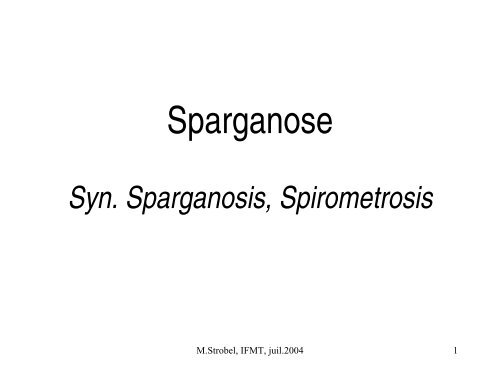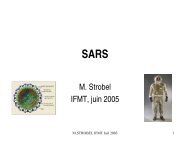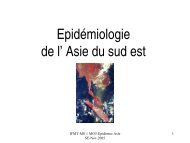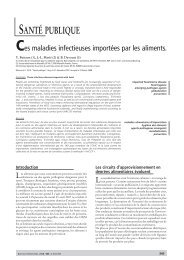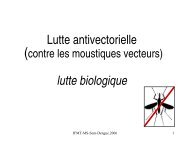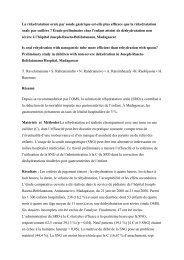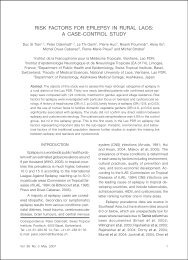Sparganose - (483.2 ko)
Sparganose - (483.2 ko)
Sparganose - (483.2 ko)
Create successful ePaper yourself
Turn your PDF publications into a flip-book with our unique Google optimized e-Paper software.
<strong>Sparganose</strong><br />
Syn. Sparganosis, Spirometrosis<br />
M.Strobel, IFMT, juil.2004 1
Medical Subject Headings, 2006_2005_11_15<br />
« Infection of animals, including fish and man, with a developmental stage<br />
of Diphyllobothrium.<br />
This stage has recently been referred to as a plerocercoid but the name<br />
sparganum has persisted. Therefore, infection of fish or other animals with<br />
the plerocercoid larvae is sparganosis.<br />
Fish-eating mammals, including man, are the final hosts."<br />
"A genus of tapeworms of the family Diphyllobothriidae, which are<br />
parasites of fish-eating cats, dogs, and birds. Infection in man is caused by<br />
eating undercooked fish. The larval form is called SPARGANUM."<br />
M.Strobel, IFMT, juil.2004 2
Généralités<br />
• Spirometra erinacei (syn. Spirometra mansoni)<br />
• un cestode intestinal animal qui parasite les poissons et<br />
batraciens<br />
• Apparenté au Diphylobothrium (bothriocéphale)<br />
• Les larves peuvent accidentellement causer une maladie<br />
chez l’homme<br />
(chez lequel l’infection n’arrive pas au stade adulte)<br />
• C’est une maladie rare<br />
M.Strobel, IFMT, juil.2004 3
Généralités (2)<br />
• Contamination humaine par :<br />
– ingestion de chair crue de serpent ou grenouille<br />
– ingestion d’eau contenant larve ou hôtes intermédiaires (cyclops)<br />
– application (but thérapeutique) de chair crue sur la peau ou l’œil<br />
(Chine, Corée)<br />
• Surtout rapportée en Asie : Corée, Chine, Russie<br />
– Corée ≈100 cas rapportés<br />
– Accessoirement en Afrique de l’Est et Amérique du Sud<br />
– En fait ubiquitaire y compris pays froids (Europe, Russie)<br />
M.Strobel, IFMT, juil.2004 4
Épidémiologie<br />
• Hôte définitif = chien, chat, div. carnivores<br />
(cestode intestin)<br />
• 2 séries Hôtes intermédiaires (HI) naturels (cf cycle)<br />
– HI-1: cyclops<br />
– HI-2: poisson, grenouille (amphibiens) , serpent, crocodile..<br />
– … et accidentellement homme<br />
• C’est la larve dite plerocercoïde qui est infestante<br />
M.Strobel, IFMT, juil.2004 5
Épidémiologie (suite)<br />
• La <strong>Sparganose</strong> est une maladie rare.<br />
• Enquête de séro-prévalence en Corée portant sur<br />
– 850 adultes en bonne santé 1.9%<br />
– 2600 épileptiques 2.3%<br />
• La larve plerocercoide vit très longtemps (10 ans ? )<br />
et peut atteindre 50 cm (en gén. L x l = qqs cm x 1-2 mm )<br />
• Réinfections possibles<br />
M.Strobel, IFMT, juil.2004 6
Cycle<br />
M.Strobel, IFMT, juil.2004 7
Clinique / Traitement<br />
• Les manifestations cliniques sont non spécifiques<br />
• Les larves errent dans la peau et divers tissus<br />
superficiels ou profonds<br />
• Lésions uniques ou multiples, qqfois »prolifératives »<br />
• nodule sous cutané = manifestation la +fréquente<br />
• Œil et SNC sont les localisations les + sévères<br />
• Éosinophilie sanguine<br />
• Pas de traitement disponible<br />
hormis l’ excision chirurgicale<br />
M.Strobel, IFMT, juil.2004 8
4 types de manifestations cliniques<br />
1. Sous cutanées: lésions inflammatoires migratrices (nodule)<br />
de n’importe quel siège, y compris scrotum<br />
2. Tissus profonds : lésions urinaires, abdominales, plèvre…<br />
3. Œil: oedème péri orbitaire, inflammation de tous les tissus<br />
de l’œil, présence de larves dans la chambre antérieure<br />
panophtalmie<br />
4. Cerveau: lésions pseudo-tumorales, les + rapportées/ documentées<br />
(parce que les + sévères et difficile à diagnostiquer)<br />
ex série de 17 cas : Kim DG et al. J Neurosurg. 1996;85:1066-71<br />
M.Strobel, IFMT, juil.2004 9
Sparganosis caused by pleroceroids of D. mansonoides<br />
Source :Department of Biology at the University of North Carolina<br />
www.bioweb.uncc.edu/<br />
M.Strobel, IFMT, juil.2004 10
A revue of human sparganosis in Thailand :<br />
V Wiwanitkit. Int J Infection 2005,9:312-6.<br />
• 34 cas rapportés en 60 ans (1943 – 2002)<br />
• Localisations<br />
– Oculaire 50%<br />
– Sous cutanée 29%<br />
– SNC 15%<br />
– Autres (ORL, pulmon, os, péritoine) 12%<br />
• Facteurs de risque<br />
– Boire de l’eau dans la nature (rivière, lac) 35%<br />
– Ingestion de chair de grenouille ou serpent 15%<br />
– Pansement avec chair crue (grenouille, serpent ) 6%<br />
– Inconnu 59%<br />
M.Strobel, IFMT, juil.2004 11
Parasitoses du SNC<br />
• Cysticercose<br />
• Gnathostomose<br />
• Paragonimose<br />
• Angiostrongylose<br />
• Loase<br />
Parasitoses<br />
sous cutanées<br />
• Gnathostomose<br />
• Filarioses, etc..<br />
Diagnostic différentiel<br />
Étude Yin CI et al. Shanghai 2002:<br />
115 parasitoses du SNC*<br />
‣ Cysticercose 106 cas (92%)<br />
‣ Paragonimose<br />
‣ Sparaganose<br />
‣ Gnathostomose<br />
‣ Angiostrongylose<br />
* 2002<br />
4 cas<br />
3 cas<br />
1 cas<br />
1 cas<br />
M.Strobel, IFMT, juil.2004 12
Ver adulte (intestin du chien)<br />
© ajoupath.ajou.ac.kr/ slides/spragino2.jpg<br />
M.Strobel, IFMT, juil.2004 13
Sparganosis<br />
© Ohio State University<br />
www.biosci.ohio-state.edu/. .<br />
M.Strobel, IFMT, juil.2004 14
Larve sous la peau (Japon)<br />
www.sapporo-dermpath.com/ creep0105606/creep.html<br />
M.Strobel, IFMT, juil.2004 15
Diagnostic<br />
• Généralement sur biopsie<br />
peau, masse sous cutanée, tissus cérébral..<br />
• Séro-diagnostic existe mais non commercialisé<br />
M.Strobel, IFMT, juil.2004 16
Traitement<br />
• Aucun anti-parasitaire n’est efficace<br />
• Avec ou sans corticoïdes<br />
• La cure n’est obtenue que par l’ablation chirurgicale<br />
de la larve ( pas toujours facile !)<br />
M.Strobel, IFMT, juil.2004 17
Références<br />
• V Wiwanitkit. A revue of human sparganosis in Thailand :<br />
Int J Infection 2005,9:312-6.<br />
• Holodniy M, et al.. Cerebral sparganosis: case report and review. Rev<br />
Infect Dis 1991;13:155—9.<br />
• Jeong SC, et al. Cerebral sparganosis with intracerebral hemorrhage: a<br />
case report Neurology. 1998;50:503-6. ..<br />
• Kim CY, et al.. Cerebral sparganosis in a child. Pediatr Neurosurg.<br />
1997;26:103-6. 14.<br />
• Kim DG et al. Cerebral sparganosis: clinical manifestations, treatment,<br />
and outcome. J Neurosurg. 1996 ;85:1066-71.<br />
M.Strobel, IFMT, juil.2004 18


